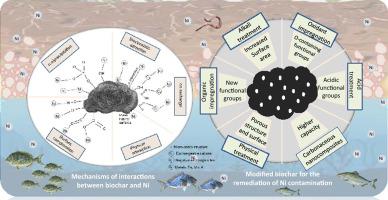Journal of Hazardous Materials ( IF 12.2 ) Pub Date : 2021-06-16 , DOI: 10.1016/j.jhazmat.2021.126421 Ali El-Naggar 1 , Naveed Ahmed 2 , Ahmed Mosa 3 , Nabeel Khan Niazi 4 , Balal Yousaf 5 , Anket Sharma 6 , Binoy Sarkar 7 , Yanjiang Cai 8 , Scott X Chang 9

|
Nickel (Ni) is a potentially toxic element that contaminates soil and water, threatens food and water security, and hinders sustainable development globally. Biochar has emerged as a promising novel material for remediating Ni-contaminated environments. However, the potential for pristine and functionalized biochars to immobilize/adsorb Ni in soil and water, and the mechanisms involved have not been systematically reviewed. Here, we critically review the different dimensions of Ni contamination and remediation in soil and water, including its occurrence and biogeochemical behavior under different environmental conditions and ecotoxicological hazards, and its remediation using biochar. Biochar is effective in immobilizing Ni in soil and water via ion exchange, electrostatic attraction, surface complexation, (co)precipitation, physical adsorption, and reduction due to the biogeochemistry of Ni and the interaction of Ni with surface functional groups and organic/inorganic compounds contained in biochar. The efficiency for Ni removal is consistently greater with functionalized than pristine biochars. Physical (e.g., ball milling) and chemical (e.g., alkali/acidic treatment) activation achieve higher surface area, porosity, and active surface groups on biochar that enhance Ni immobilization. This review highlights possible risks and challenges of biochar application in Ni remediation, suggests future research directions, and discusses implications for environmental agencies and decision-makers.
中文翻译:

土壤和水中的镍:来源、生物地球化学和使用生物炭的修复
镍 (Ni) 是一种潜在的有毒元素,会污染土壤和水,威胁粮食和水安全,并阻碍全球的可持续发展。生物炭已成为一种有前途的新型材料,可用于修复受镍污染的环境。然而,原始的和功能化的生物炭在土壤和水中固定/吸附镍的潜力,以及所涉及的机制尚未得到系统的审查。在这里,我们批判性地回顾了土壤和水中 Ni 污染和修复的不同维度,包括其在不同环境条件和生态毒理学危害下的发生和生物地球化学行为,以及使用生物炭进行修复。生物炭通过离子交换、静电吸引、表面络合、(共)沉淀、物理吸附、由于 Ni 的生物地球化学以及 Ni 与生物炭中含有的表面官能团和有机/无机化合物的相互作用而导致的还原。与原始生物炭相比,功能化的 Ni 去除效率始终更高。物理(例如,球磨)和化学(例如,碱/酸处理)活化可在生物炭上实现更高的表面积、孔隙率和活性表面基团,从而增强 Ni 的固定化。本综述强调了生物炭在镍修复中应用的可能风险和挑战,提出了未来的研究方向,并讨论了对环境机构和决策者的影响。与原始生物炭相比,功能化的 Ni 去除效率始终更高。物理(例如,球磨)和化学(例如,碱/酸处理)活化可在生物炭上实现更高的表面积、孔隙率和活性表面基团,从而增强 Ni 的固定化。本综述强调了生物炭在镍修复中应用的可能风险和挑战,提出了未来的研究方向,并讨论了对环境机构和决策者的影响。与原始生物炭相比,功能化的 Ni 去除效率始终更高。物理(例如,球磨)和化学(例如,碱/酸处理)活化可在生物炭上实现更高的表面积、孔隙率和活性表面基团,从而增强 Ni 的固定化。本综述强调了生物炭在镍修复中应用的可能风险和挑战,提出了未来的研究方向,并讨论了对环境机构和决策者的影响。











































 京公网安备 11010802027423号
京公网安备 11010802027423号